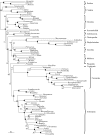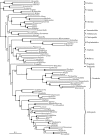Improvement of molecular phylogenetic inference and the phylogeny of Bilateria
- PMID: 18192187
- PMCID: PMC2615818
- DOI: 10.1098/rstb.2007.2236
Improvement of molecular phylogenetic inference and the phylogeny of Bilateria
Abstract
Inferring the relationships among Bilateria has been an active and controversial research area since Haeckel. The lack of a sufficient number of phylogenetically reliable characters was the main limitation of traditional phylogenies based on morphology. With the advent of molecular data, this problem has been replaced by another one, statistical inconsistency, which stems from an erroneous interpretation of convergences induced by multiple changes. The analysis of alignments rich in both genes and species, combined with a probabilistic method (maximum likelihood or Bayesian) using sophisticated models of sequence evolution, should alleviate these two major limitations. We applied this approach to a dataset of 94 genes and 79 species using CAT, a previously developed model accounting for site-specific amino acid replacement patterns. The resulting tree is in good agreement with current knowledge: the monophyly of most major groups (e.g. Chordata, Arthropoda, Lophotrochozoa, Ecdysozoa, Protostomia) was recovered with high support. Two results are surprising and are discussed in an evo-devo framework: the sister-group relationship of Platyhelminthes and Annelida to the exclusion of Mollusca, contradicting the Neotrochozoa hypothesis, and, with a lower statistical support, the paraphyly of Deuterostomia. These results, in particular the status of deuterostomes, need further confirmation, both through increased taxonomic sampling, and future improvements of probabilistic models.
Figures



References
-
- Abouheif E, Zardoya R, Meyer A. Limitations of metazoan 18S rRNA sequence data: implications for reconstructing a phylogeny of the animal kingdom and inferring the reality of the Cambrian explosion. J. Mol. Evol. 1998;47:394–405. doi:10.1007/PL00006397 - DOI - PubMed
-
- Adoutte A, Balavoine G, Lartillot N, de Rosa R. Animal evolution. The end of the intermediate taxa? Trends Genet. 1999;15:104–108. doi:10.1016/S0168-9525(98)01671-0 - DOI - PubMed
-
- Adoutte A, Balavoine G, Lartillot N, Lespinet O, Prud'homme B, de Rosa R. The new animal phylogeny: reliability and implications. Proc. Natl Acad. Sci. USA. 2000;97:4453–4456. doi:10.1073/pnas.97.9.4453 - DOI - PMC - PubMed
-
- Aguinaldo A.M, Turbeville J.M, Linford L.S, Rivera M.C, Garey J.R, Raff R.A, Lake J.A. Evidence for a clade of nematodes, arthropods and other moulting animals. Nature. 1997;387:489–493. doi:10.1038/387489a0 - DOI - PubMed
-
- Arendt D, Nubler-Jung K. Inversion of dorsoventral axis? Nature. 1994;371:26. doi:10.1038/371026a0 - DOI - PubMed
Publication types
MeSH terms
LinkOut - more resources
Full Text Sources
Miscellaneous
